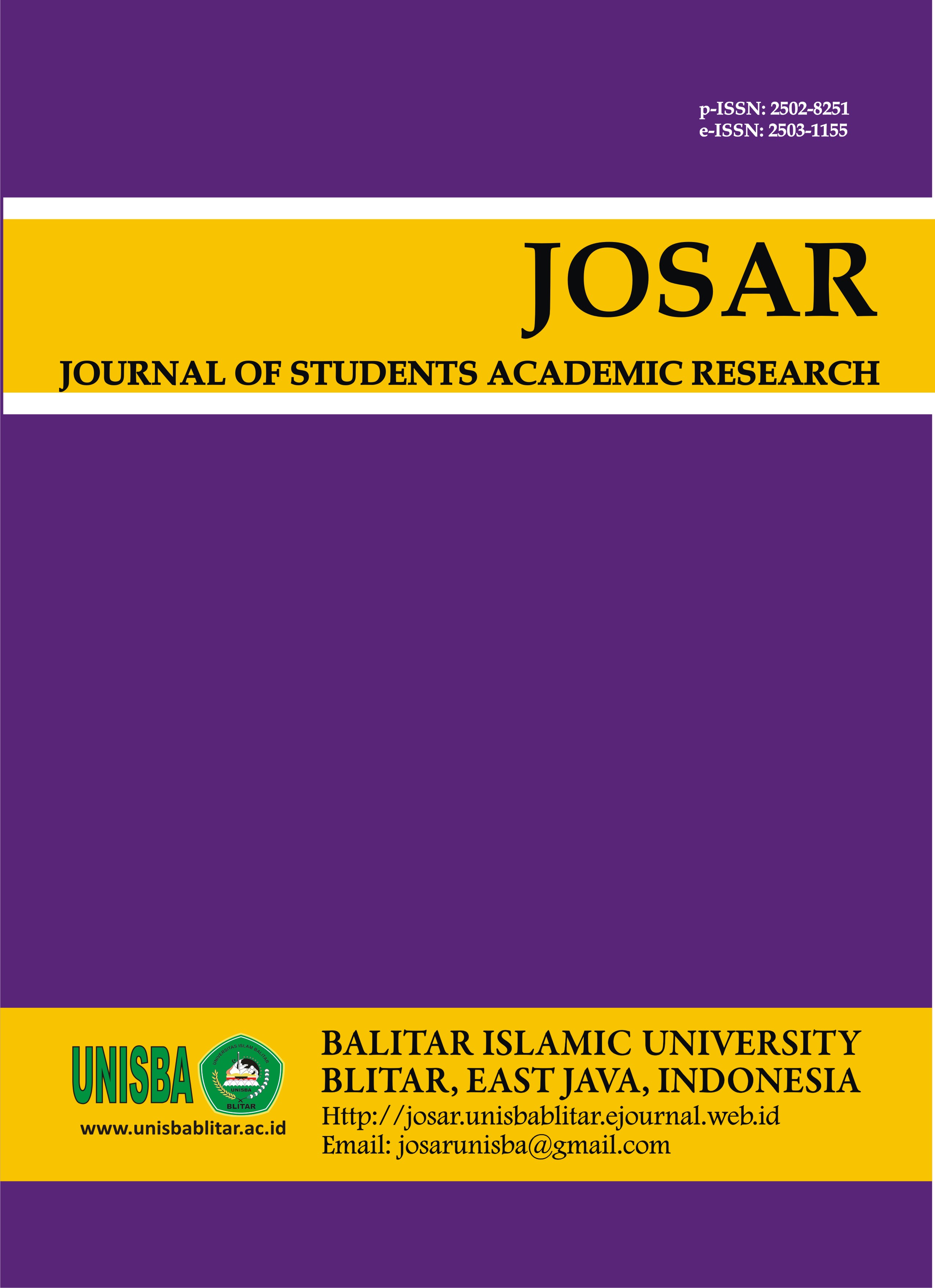DEVELOPMENT OF SOCIO-CULTURAL-BASED PHOTONOVELA MEDIA TO IMPROVE POSTER WRITING SKILLS OF CLASS VIII STUDENTS OF SMP/MTs
DOI:
https://doi.org/10.35457/josar.v9i1.2798Keywords:
Media Pembelajaran, Fotonovel, PosterAbstract
Poster adalah media yang digunakan untuk menyampaikan hal-hal penting atau informasi, saran, pesan, ide, dan gagasan sehingga dapat merangsang pembaca untuk melihat dan membacanya. Poster berisi gambar dan teks yang menarik. Berdasarkan observasi di SMP Muhammadiyah 2 Kota Blitar, selama proses pembelajaran dan melalui wawancara dengan siswa dan guru mata pelajaran bahasa Indonesia masih banyak siswa yang kurang tertarik dengan proses pembelajaran khususnya materi menulis poster. Banyak siswa yang masih kesulitan menemukan ide saat membuat poster. Penelitian ini menggunakan metode penelitian 4D. Hasil penilaian dari responden yaitu ahli materi, ahli media, guru bahasa Indonesia, dan siswa didapatkan hasil yaitu ahli materi dengan 2 aspek komponen mendapatkan persentase sebesar 81,5% yang berarti layak untuk dilaksanakan. Ahli media dengan 2 aspek komponen mendapatkan persentase sebesar 87% yang berarti sangat layak untuk diterapkan. Guru Bahasa Indonesia dengan 4 aspek komponen mendapatkan persentase sebesar 95,7% yang berarti sangat layak untuk diterapkan. Siswa dengan 3 aspek komponen mendapatkan persentase 89,3% yang berarti sangat layak untuk diterapkan. Dari hasil persentase keseluruhan dapat disimpulkan bahwa media fotonovela sangat layak untuk diimplementasikan dalam proses pembelajaran untuk mencapai tujuan pembelajaran yang diharapkan.
References
Astuti, P. (2017). Peningkatan Motivasi dan Kemampuan Berpikir Kreatif Siswa pada Materi Pencemaran Lingkungan melalui Media Fotonovela. Refleksi Edukatika: Jurnal Ilmiah Kependidikan, 8(1).
Bryk, A. S., Gomez, L. M., Grunow, A., & LeMahieu, P. G. (2015). Learning to improve: How America’s schools can get better at getting better. Harvard Education Press.
Davis, H. D. (2017). “Spyt kom te laat” The development and evaluation of a health- related fotonovela about methamphetamine (“tik”) use in the Western Cape and Northern Cape provinces of South Africa. Stellenbosch: Stellenbosch University.
Edi, F. R. S. (2016). teori wawancara Psikodignostik. Penerbit LeutikaPrio. Fibriantie, S., Sukidin, S., & Suparti, S. (2021). The Effect of Project-Based Learning
Implementation with Photonovel Media on Science Process Skill and Critical Thinking Ability of the IV Grade Students at SDN Wirowongso 01. Pancaran Pendidikan, 10(4).
Foley, J., & Thompson, L. (2017). Language learning: A lifelong process. Routledge.
Gunawan, I. (2017). Indonesian Curriculum 2013: Instructional management, obstacles faced by teachers in implementation and the way forward. 3rd International Conference on Education and Training (ICET 2017), 56–63.
Kirova, A., & Emme, M. (2008). Fotonovela as a research tool in image-based participatory research with immigrant children. International Journal of Qualitative Methods, 7(2), 35–57.
Kozma, R. B. (1991). Learning with media. Review of Educational Research, 61(2), 179– 211.
Kurniawati, R., Hermawan, A., & Sa’diyah, L. (2023). PENGEMBANGAN MEDIA KLIPING DALAM PEMBELAJARAN MENULIS TEKS PROSEDUR PADA SISWA KELAS XI
SMA/MA. Jurnal PENEROKA: Kajian Ilmu Pendidikan Bahasa Dan Sastra Indonesia, 3(1), 1–13.
Laurillard, D. (2013). Rethinking university teaching: A conversational framework for the effective use of learning technologies. Routledge.
Mehmood, E., Abid, A., Farooq, M. S., & Nawaz, N. A. (2020). Curriculum, teaching and learning, and assessments for introductory programming course. IEEE Access, 8, 125961–125981.
Mohajan, H. K. (2017). Two criteria for good measurements in research: Validity and reliability. Annals of Spiru Haret University. Economic Series, 17(4), 59–82.
Puspitarini, Y. D., & Hanif, M. (2019). Using Learning Media to Increase Learning Motivation in Elementary School. Anatolian Journal of Education, 4(2), 53–60.
Short, D. J. (2017). How to integrate content and language learning effectively for English language learners. Eurasia Journal of Mathematics, Science and Technology Education, 13(7b), 4237–4260.
Sugiyono, P. D. (2017). Metode penelitian bisnis: pendekatan kuantitatif, kualitatif, kombinasi, dan R&D. Penerbit CV. Alfabeta: Bandung, 225, 87.
Sugiyono, S. (2017). Metode penelitian & pengembangan. Research and Development.
Alfabeta.
Utomo, C., & Wasino, W. (2020). An Integrated Teaching Tolerance in Learning History of Indonesian National Movement at Higher Education. Journal of Social Studies Education Research, 11(3), 65–108.
Yaacob, A., & Lubis, A. H. (2022). The Development of Web-Based Teaching Materials Integrated with Indonesian Folklore for Indonesian Language for Foreign Speakers Students. International Journal of Language Education, 6(1), 46–62.
Yayuk, S., & Sugiyono, S. (2019). Pengaruh kepemimpinan kepala sekolah dan biaya pendidikan terhadap kualitas proses belajar mengajar dan dampaknya dengan kompetensi lulusan SMK di kabupaten Gunungkidul. Jurnal Akuntabilitas Manajemen Pendidikan, 7(1), 84–96.
Yildirim, C., & Correia, A.-P. (2015). Exploring the dimensions of nomophobia: Development and validation of a self-reported questionnaire. Computers in Human Behavior, 49, 130–137.
Downloads
Published
Issue
Section
License
Authors who publish in this journal agree to the following terms:
- Authors retain copyright and grant the journal right of first publication with the work simultaneously licensed under a Creative Commons Attribution License that allows others to share the work with an acknowledgment of the work's authorship and initial publication in this journal.
- Authors are able to enter into separate, additional contractual arrangements for the non-exclusive distribution of the journal's published version of the work (e.g., post it to an institutional repository or publish it in a book), with an acknowledgment of its initial publication in this journal.
- Authors are permitted and encouraged to post their work online (e.g., in institutional repositories or on their website) prior to and during the submission process, as it can lead to productive exchanges, as well as earlier and greater citation of published work (See The Effect of Open Access).
Deprecated: json_decode(): Passing null to parameter #1 ($json) of type string is deprecated in /home/ejournal.unisbablitar.ac.id/public_html/plugins/generic/citations/CitationsPlugin.php on line 68










